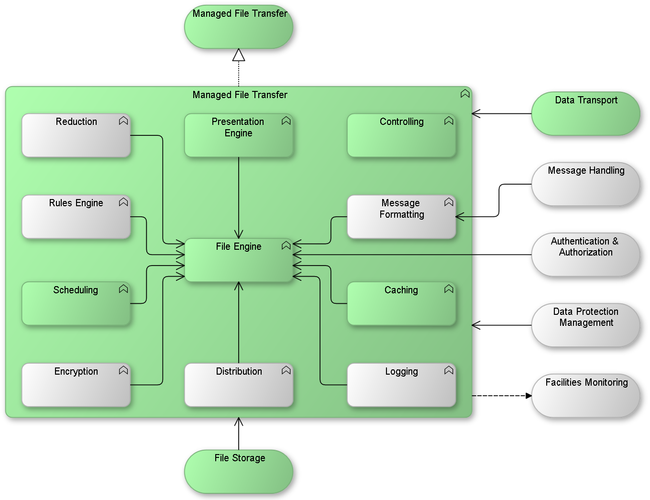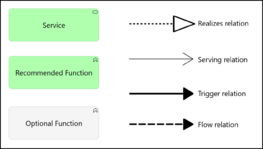GP.Managed File Transfer
| Page maturity This page has maturity level 2 (young) |
| GP | Managed File Transfer | Version: | 0.1 | 
| |
|---|---|---|---|---|---|
| Document type: | Generic Pattern | Owner: |
| This Pattern provides a means to transport loosely structured data from a source to one or more targets, either ad hoc or structurally.. |
Description
This Generic Pattern belongs to "Business Support". A realization of this Pattern handles the reception and/or collection of data in a loosely structured form ("files") from a source, and their delivery to and/or collection by one or more targets. It may also additionally modify the files by transcoding, encrypting/decrypting, (de)compressing, and/or it may provide means to modify the files in transit in other respects. Incoming and outgoing traffic may be regulated using predescribed rules and/or by schedules that act on times, periods or order. The Pattern requires use of an instance of Data Transport (and optionally Message Handling), since the data to be transported comes in and goes out over these services. Most data transfers will require the Managed File Transfer Pattern to authenticate itself to the source and/or target. Furthermore functionality can be present to provide logging of each file transfer for operational and security purposes.
Services realized
This Pattern realizes the following service(s):
- Managed File Transfer (This service provides a means to transport loosely structured data from a source to one or more targets, either ad hoc or structurally.)
Functional and Integration view
This is the graphic representation of the functional model of this Generic Pattern:


Generic Pattern Composition
This pattern is an aggregation of the following (mandatory and optional) functions, expressed in Generic Functions:
| Icon | Function | Inclusion | Rationale |
| Rules Engine | recommended | This function represents the intelligence that drives extra manipulation of files in transit, advanced exception handling, logging and/or routing by the Pattern. Active collection of information on the files in transit, source and/or target(s) may lead to execution of (implicit or explicit) rules. | |
| Logging | optional | This function is often included, as logs of file transfers are required not only by Operations, but also Security/Compliance. Furthermore, a business entity responsible for sending files, or one that expects incoming files, may require access to the logged information to verify data transfers. | |
| Scheduling | optional | Scheduling can serve to initiate file tranfers and/or internal maintenance tasks, on regular or predetermined times. | |
| Controlling | recommended | This function models the manner in which the Pattern's administrators, and possibly authorized clients, can administer file transfers. Among the administrative tasks can be the following:
Since the files transferred by the Pattern may be business critical and/or have a certain level of confidentiality, care must be taken to limit access to this function to authorized users. |
Services connected with this Generic Pattern
This Generic Pattern has the following mandatory and optional relations with adjacent Generic Services.
| Service | Adjacency | Summary | Rationale |
| Authentication & Authorization | optional | This service can validate an identity claim, and it can validate the permissions required for an action, as part of an Authentication & Authorization process. | The Pattern will likely be required to authenticate itself when collecting and/or delivering a file. Furthermore, the Pattern probably will require systems and users to authenticate themselves when they wish to transfer or collect files. Finally, access to the services provided by the Managed File Transfer Pattern must likely be limited to authorized personnel. |
Applied Patterns based on this Generic Pattern
The following Applied Patterns are based wholly or in part on this Generic Pattern: